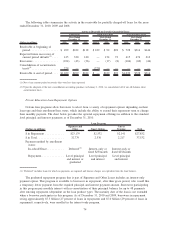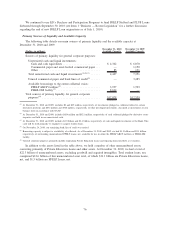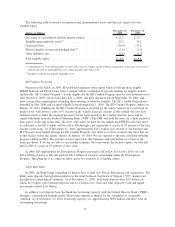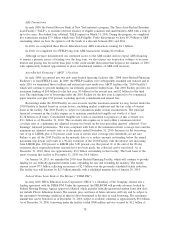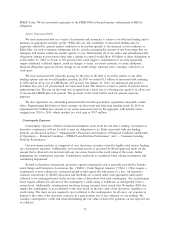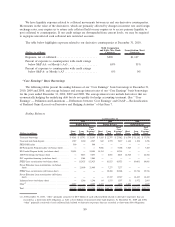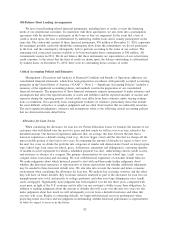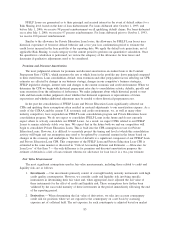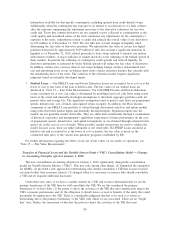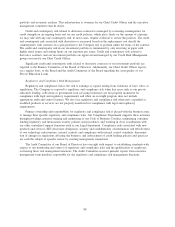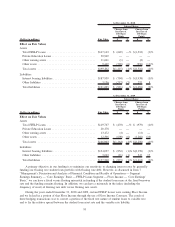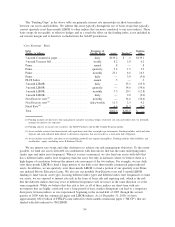Sallie Mae 2010 Annual Report Download - page 85
Download and view the complete annual report
Please find page 85 of the 2010 Sallie Mae annual report below. You can navigate through the pages in the report by either clicking on the pages listed below, or by using the keyword search tool below to find specific information within the annual report.information available for that specific counterparty, including spreads from credit default swaps.
Additionally, when the counterparty has exposure to us related to our derivatives, we fully collater-
alize the exposure, minimizing the adjustment necessary to the derivative valuations for our own
credit risk. Trusts that contain derivatives are not required to post collateral to counterparties as the
credit quality and securitized nature of the trusts minimizes any adjustments for the counterparty’s
exposure to the trusts. Adjustments related to credit risk reduced the overall value of our derivatives
by $72 million as of December 31, 2010. We also take into account changes in liquidity when
determining the fair value of derivative positions. We adjusted the fair value of certain less liquid
positions downward by approximately $129 million to take into account a significant reduction in
liquidity as of December 31, 2010, related primarily to basis swaps indexed to interest rate indices
with inactive markets. A major indicator of market inactivity is the widening of the bid/ask spread in
these markets. In general, the widening of counterparty credit spreads and reduced liquidity for
derivative instruments as indicated by wider bid/ask spreads will reduce the fair value of derivatives.
In addition, certain cross-currency interest rate swaps hedging foreign currency denominated reset
rate and amortizing notes in our on-balance sheet trusts contain extension features that coincide with
the remarketing dates of the notes. The valuation of the extension feature requires significant
judgment based on internally developed inputs.
3. Student Loans — Our FFELP Loans and Private Education Loans are accounted for at cost or at the
lower of cost or fair value if the loan is held-for-sale. The fair values of our student loans are
disclosed in “Note 15 — Fair Value Measurements.” For both FFELP Loans and Private Education
Loans accounted for at cost, fair value is determined by modeling loan level cash flows using stated
terms of the assets and internally-developed assumptions to determine aggregate portfolio yield, net
present value and average life. The significant assumptions used to project cash flows are prepayment
speeds, default rates, cost of funds, and required return on equity. In addition, the Floor Income
component of our FFELP Loan portfolio is valued through discounted cash flow and option models
using both observable market inputs and internally developed inputs. Significant inputs into the
models are not generally market observable. They are either derived internally through a combination
of historical experience and management’s qualitative expectation of future performance (in the case
of prepayment speeds, default rates, and capital assumptions) or are obtained through external broker
quotes (as in the case of cost of funds). When possible, market transactions are used to validate the
model. In most cases, these are either infrequent or not observable. For FFELP Loans classified as
held-for-sale and accounted for at the lower of cost or market, the fair value is based on the
committed sales price of the various loan purchase programs established by ED.
For further information regarding the effect of our use of fair values on our results of operations, see
“Note 15 — Fair Value Measurements.”
Transfers of Financial Assets and the Variable Interest Entity (“VIE”) Consolidation Model — Changes
in Accounting Principles effective January 1, 2010
The new consolidation accounting adopted on January 1, 2010 significantly changed the consolidation
model for Variable Interest Entities (“VIEs”). This new rule, among other things, (1) eliminated the exemption
for QSPEs, (2) provided a new approach for determining who should consolidate a VIE that is more focused
on control rather than economic interest, (3) changed when it is necessary to reassess who should consolidate
a VIE and (4) required additional disclosure.
Under these new rules, if we have a variable interest in a VIE and we have determined that we are the
primary beneficiary of the VIE then we will consolidate the VIE. We are the considered the primary
beneficiary if we have both: (1) the power to direct the activities of the VIE that most significantly impact the
VIE’s economic performance and (2) the obligation to absorb losses or receive benefits of the entity that could
potentially be significant to the VIE. There is considerable judgment that has to be used as it relates to
determining who is the primary beneficiary of the VIEs with which we are associated. There are no “bright
line” tests. Rather, the assessment of who has the power to direct the activities of the VIE that most
84


